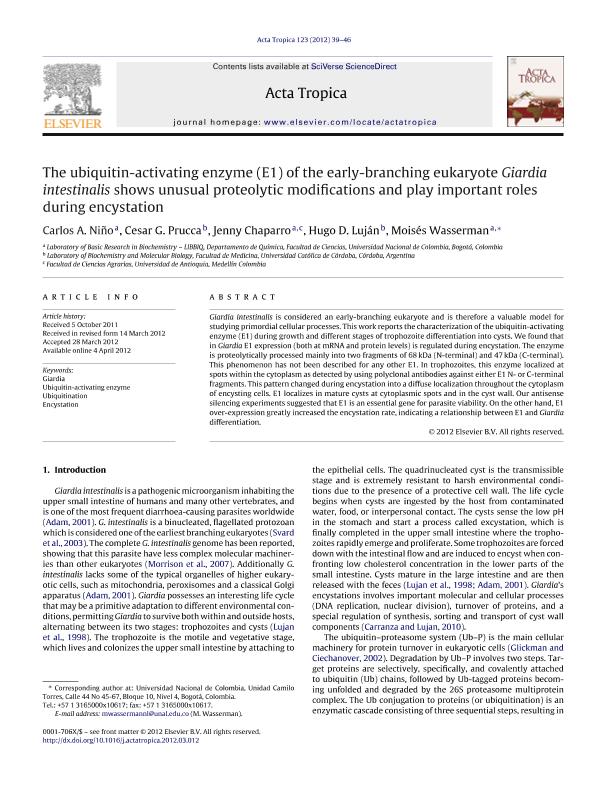Mostrar el registro sencillo del ítem
dc.contributor.author
Niño, Carlos A.
dc.contributor.author
Prucca, Cesar German

dc.contributor.author
Chaparro, Jenny
dc.contributor.author
Lujan, Hugo Daniel

dc.contributor.author
Wasserman, Moisés
dc.date.available
2023-03-17T16:38:35Z
dc.date.issued
2012-07
dc.identifier.citation
Niño, Carlos A.; Prucca, Cesar German; Chaparro, Jenny; Lujan, Hugo Daniel; Wasserman, Moisés; The ubiquitin-activating enzyme (E1) of the early-branching eukaryote Giardia intestinalis shows unusual proteolytic modifications and play important roles during encystation; Elsevier Science; Acta Tropica; 123; 1; 7-2012; 39-46
dc.identifier.issn
0001-706X
dc.identifier.uri
http://hdl.handle.net/11336/190937
dc.description.abstract
Giardia intestinalis is considered an early-branching eukaryote and is therefore a valuable model for studying primordial cellular processes. This work reports the characterization of the ubiquitin-activating enzyme (E1) during growth and different stages of trophozoite differentiation into cysts. We found that in Giardia E1 expression (both at mRNA and protein levels) is regulated during encystation. The enzyme is proteolytically processed mainly into two fragments of 68. kDa (N-terminal) and 47. kDa (C-terminal). This phenomenon has not been described for any other E1. In trophozoites, this enzyme localized at spots within the cytoplasm as detected by using polyclonal antibodies against either E1 N- or C-terminal fragments. This pattern changed during encystation into a diffuse localization throughout the cytoplasm of encysting cells. E1 localizes in mature cysts at cytoplasmic spots and in the cyst wall. Our antisense silencing experiments suggested that E1 is an essential gene for parasite viability. On the other hand, E1 over-expression greatly increased the encystation rate, indicating a relationship between E1 and Giardia differentiation. © 2012 Elsevier B.V.
dc.format
application/pdf
dc.language.iso
eng
dc.publisher
Elsevier Science

dc.rights
info:eu-repo/semantics/openAccess
dc.rights.uri
https://creativecommons.org/licenses/by-nc-sa/2.5/ar/
dc.subject
ENCYSTATION
dc.subject
GIARDIA
dc.subject
UBIQUITIN-ACTIVATING ENZYME
dc.subject
UBIQUITINATION
dc.subject.classification
Biología Celular, Microbiología

dc.subject.classification
Ciencias Biológicas

dc.subject.classification
CIENCIAS NATURALES Y EXACTAS

dc.title
The ubiquitin-activating enzyme (E1) of the early-branching eukaryote Giardia intestinalis shows unusual proteolytic modifications and play important roles during encystation
dc.type
info:eu-repo/semantics/article
dc.type
info:ar-repo/semantics/artículo
dc.type
info:eu-repo/semantics/publishedVersion
dc.date.updated
2023-03-15T20:34:57Z
dc.journal.volume
123
dc.journal.number
1
dc.journal.pagination
39-46
dc.journal.pais
Países Bajos

dc.journal.ciudad
Amsterdam
dc.description.fil
Fil: Niño, Carlos A.. Universidad Nacional de Colombia; Colombia
dc.description.fil
Fil: Prucca, Cesar German. Consejo Nacional de Investigaciones Científicas y Técnicas. Centro Científico Tecnológico Conicet - Córdoba. Centro de Investigaciones en Química Biológica de Córdoba. Universidad Nacional de Córdoba. Facultad de Ciencias Químicas. Centro de Investigaciones en Química Biológica de Córdoba; Argentina
dc.description.fil
Fil: Chaparro, Jenny. Universidad Nacional de Colombia; Colombia. Universidad de Antioquia; Colombia
dc.description.fil
Fil: Lujan, Hugo Daniel. Consejo Nacional de Investigaciones Científicas y Técnicas. Centro de Investigación y Desarrollo en Inmunología y Enfermedades Infecciosas. Universidad Católica de Córdoba. Centro de Investigación y Desarrollo en Inmunología y Enfermedades Infecciosas; Argentina
dc.description.fil
Fil: Wasserman, Moisés. Universidad Nacional de Colombia; Colombia
dc.journal.title
Acta Tropica

dc.relation.alternativeid
info:eu-repo/semantics/altIdentifier/doi/http://dx.doi.org/10.1016/j.actatropica.2012.03.012
dc.relation.alternativeid
info:eu-repo/semantics/altIdentifier/url/https://www.sciencedirect.com/science/article/pii/S0001706X12001647
Archivos asociados
